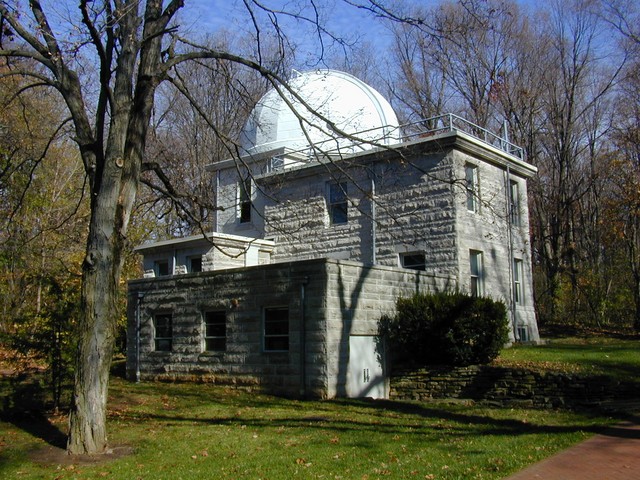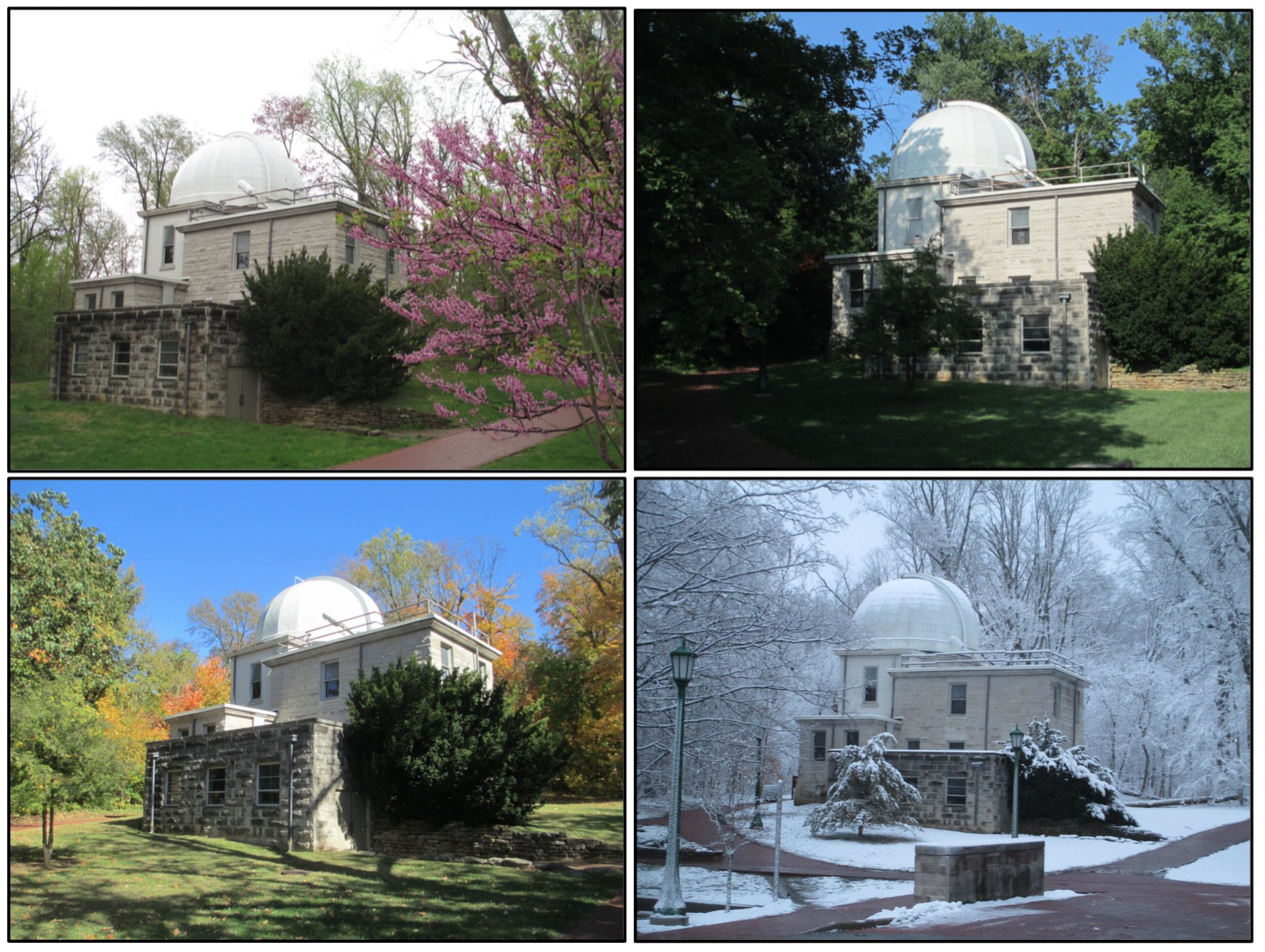Kirkwood Observatory Information
[Kirkwood Observatory Schedule]
Groups
Group showings are available by contacting the Astronomy Department at (812) 855-6911, or by sending email to astoutre [at] indiana.edu.
Kirkwood Observatory
Located at the edge of campus between the woods and where Indiana Avenue meets 4th street, this building is the most obvious and accessible of our facilities. It houses a 0.3 meter (12 inch) refracting telescope which is staffed for free public viewing each Wednesday evening, March through November, when classes are in session. If the weather is clear, the observatory will be open shortly after sunset. No reservations are necessary.
 The Kirkwood Observatory solar telescope is an instructional instrument consisting of a rooftop mounted heliostat that directs a beam of sunlight into a dedicated room. In that room, the beam is divided among several optical benches. The first produces a very large white light image of the sun that is used to view sunspots and limb darkening. Next is a spectrograph to examine the spectral colors and absorption lines. Third, a hydrogen-alpha image of the sun is displayed on a TV screen so that prominances, flares, and other active regions can be studied. A spare optical bench can be used for special experiments on the solar spectrum or image.
The Kirkwood Observatory solar telescope is an instructional instrument consisting of a rooftop mounted heliostat that directs a beam of sunlight into a dedicated room. In that room, the beam is divided among several optical benches. The first produces a very large white light image of the sun that is used to view sunspots and limb darkening. Next is a spectrograph to examine the spectral colors and absorption lines. Third, a hydrogen-alpha image of the sun is displayed on a TV screen so that prominances, flares, and other active regions can be studied. A spare optical bench can be used for special experiments on the solar spectrum or image.
Kirkwood Observatory has a solar telescope with which solar phenomena can be studied.
History of the Observatory
 The Kirkwood Observatory was constructed in 1900 and dedicated on May 15, 1901. The dedication address was given by the eminent astronomer William J. Hussey, a member of the staff of the Lick Observatory, Mount Hamilton, California. The title of his talk was: Astronomy in Modern Life. President Joseph Swain spoke about his teacher and mentor, Daniel Kirkwood.
The Kirkwood Observatory was constructed in 1900 and dedicated on May 15, 1901. The dedication address was given by the eminent astronomer William J. Hussey, a member of the staff of the Lick Observatory, Mount Hamilton, California. The title of his talk was: Astronomy in Modern Life. President Joseph Swain spoke about his teacher and mentor, Daniel Kirkwood.
Kirkwood Hall, also built during the Swain administration, was dedicated on January 25, 1895, 4 ½ months before Daniel Kirkwood's death. East Fifth Street had been re-named Kirkwood Avenue in 1885, a year before he retired.
Kirkwood's research on comets, meteors, and asteroids established a tradition of astronomical research at Indiana University. The first director of the Kirkwood Observatory, John A. Miller, made plans for the Kirkwood Observatory that continued this tradition. He had become interested in visual binary stars and his plans for the observatory included purchase of equipment for use with the 12-inch telescope to measure visual binary stars. He also got approval from President Swain to hire Wilbur A. Cogshall, an experienced visual binary star observer who had worked as T.J.J. See's assistant at the Lowell Observatory, Flagstaff, Arizona for several years. Cogshall came to Bloomington in 1900. Miller and Cogshall were active as a team making observations of visual binary stars from 1901 to 1906, when Miller left to join Joseph Swain at Swarthmore College. Swain had been President of Swarthmore since 1902. Cogshall was appointed Director of the Kirkwood Observatory in 1907 and served in that capacity until he retired in 1944.
Cogshall faithfully finished and published the visual binary measurements that Miller and he had made, but he had no interest in starting new observing programs. He was more interested in astronomical instruments and optics and set up a small optical shop in the basement of the Kirkwood Observatory. He had access to the Physics Department shop when he needed to use machine tools. He made an 8-inch reflector which took a 2x2 inch photographic plate at the prime focus. He mounted it on the 12-inch refractor, and used it to take photographs of Halley's Comet and other comets that were used by comet researchers many years later. He made the optical parts for a 24-inch Schwarzschild reflector, which was mounted in a small dome southeast of Bloomington. Problems with the mounting had not been solved when he retired. He was on leave in the second semester 1928-29 to serve as Chief Scientist of the U.S. Naval Observatory Eclipse Expedition to a site in the Philippine Islands. Major equipment was set up under his supervision to make photographic observations of the total solar eclipse on May 9, 1929.
Frank K. Edmondson enrolled as a Freshman in the Fall of 1929. Cogshall was his teacher for the basic techniques of astronomical photography. K.P. Williams, a mathematics professor showed him how to use the transit instrument in the Kirkwood Observatory to evaluate the clock correction for the sidereal clock. He also taught the course in orbit calculation.
Edmondson graduated in 1933. After two years at the Lowell Observatory and two years at Harvard, he was appointed Instructor in Astronomy at IU in 1937 by President William Lowe Bryan, Swain's successor as President in 1902. Dr. Bryan took a course in Analytic Geometry from Daniel Kirkwood in 1880. When Cogshall retired in 1944, Edmondson became the third Director of the Kirkwood Observatory



